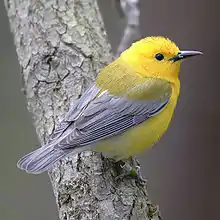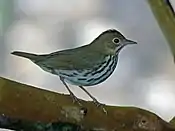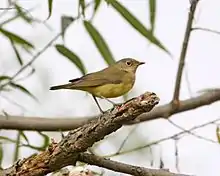New World warbler
The New World warblers or wood-warblers are a group of small, often colorful, passerine birds that make up the family Parulidae and are restricted to the New World. They are not closely related to Old World warblers or Australian warblers. Most are arboreal, but some, like the ovenbird and the two waterthrushes, are primarily terrestrial. Most members of this family are insectivores.
| New World warbler | |
|---|---|
 | |
| Prothonotary warbler (Protonotaria citrea) | |
| Scientific classification | |
| Kingdom: | Animalia |
| Phylum: | Chordata |
| Class: | Aves |
| Order: | Passeriformes |
| Superfamily: | Passeroidea |
| Family: | Parulidae Wetmore et al., 1947 |
| Species | |
|
See text | |
| Synonyms | |
|
Mniotiltidae | |
This group likely originated in northern Central America, where the greatest number of species and diversity between them is found. From there, they spread north during the interglacial periods, mainly as migrants, returning to the ancestral region in winter. Two genera, Myioborus and Basileuterus, seem to have colonized South America early, perhaps before the two continents were linked, and together constitute most warbler species of that region.
The scientific name for the family, Parulidae, originates from the fact that Linnaeus in 1758 named the northern parula as a tit, Parus americanus, and as taxonomy developed, the genus name was modified first to Parulus and then to Parula. The family name derives from the name for the genus.
Taxonomy
| |||||||||||||||||||||||||||||||||||||||||||||||||||||||||||||||||||||||||||||||||||||||||||||||||||||||||
| Cladogram showing the relationships between the genera[1][2] |
The family Parulidae was introduced for the New World warblers in 1947 by American ornithologist Alexander Wetmore and colleagues with Parula as the type genus.[3]
The family is sister to a clade containing the yellow-breasted chat in its own family Icteriidae, the wrenthrush in its own family Zeledoniidae, the two Cuban warblers in the family Teretistridae and the 109 species in the family Icteridae.[4][1]
A molecular phylogenetic study of the Parulidae published in 2010 found that the species formed several major clades that did not align with the traditional genera.[2] This led to a major reorganization of the species within the family to create monotypic genera. The changes have generally followed the recommendations of the authors of the study except in a few cases where the proposed genera were split to separate basal species from their proposed conspecifics.[1][2]
A large clade that included the 29 species then placed in the genus Dendroica, also included four species of Parula, one of the three species of Wilsonia and the monotypic genera Catharopeza and Setophaga. All members of the clade apart from the basal Catharopeza were placed in the expanded genus Setophaga Swainson, 1827, which under the rules of the International Code of Zoological Nomenclature, had priority over Dendroica Gray, 1842, Wilsonia Bonaparte, 1838, and Parula Bonaparte, 1838.[1][2]
The species that had traditionally been placed in Basileuterus formed two clades. One group retains the genus name as it includes the golden-crowned warbler, the type species for the genus. The other larger group, now with 18 species, is placed in the resurrected genus Myiothlypis Cabanis, 1850, as it contains the type species, the black-crested warbler.[1][2]
The genus Myioborus containing the whitestarts remained unchanged after the reorganization but six genera were no longer used: Dendroica, Ergaticus, Euthlypis, Parula, Wilsonia and Phaeothlypis.[1][2]
Extant Genera
The family Parulidae now contains 119 species divided into 18 genera.[1]
| Image | Genus | Living Species |
|---|---|---|
 | Seiurus Swainson, 1827 |
|
 | Helmitheros Rafinesque, 1819 |
|
 | Parkesia Sangster, 2008 |
|
.jpg.webp) | Vermivora Swainson, 1827 |
|
.jpg.webp) | Mniotilta Vieillot, 1816 |
|
_Sabine_Woods_TX_2018-04-21_12-18-49_(41971935551).jpg.webp) | Protonotaria Baird, 1858 |
|
.jpg.webp) | Limnothlypis Stone, 1914 |
|
 | Oreothlypis Ridgway, 1884 |
|
.jpg.webp) | Leiothlypis Sangster, 2008 |
|
 | Leucopeza Sclater, 1876 |
|
 | Oporornis Baird, 1858 |
|
 | Geothlypis Cabanis, 1847 |
|
 | Catharopeza P.L. Sclater, 1880 |
|
.jpg.webp) | Setophaga Swainson, 1827 |
|
 | Myiothlypis Cabanis, 1850 |
|
.jpg.webp) | Basileuterus Cabanis, 1848 |
|
.jpg.webp) | Cardellina Bonaparte, 1850 |
|
.jpg.webp) | Myioborus Baird, 1865 |
|
Former species
Some species that were previously placed in the Parulidae have been moved to other families:[1][2][4]
- Olive warbler (Peucedramus taeniatus) – now in own family Peucedramidae
- Yellow-breasted chat (Icteria virens) – now in own family Icteriidae
- Three species in the genus Granatellus – now in the family Cardinalidae
- Red-breasted chat (Granatellus venustus)
- Grey-throated chat (Granatellus sallaei)
- Rose-breasted chat (Granatellus pelzelni)
- Wrenthrush (Zeledonia coronata) – now in own family Zeledoniidae
- Two species endemic to Hispaniola – now in family Phaenicophilidae
- Green-tailed warbler (Microligea palustris)
- White-winged warbler (Xenoligea montana)
- Two species endemic to Cuba in the genus Teretistris – now in own family Teretistridae
- Yellow-headed warbler (Teretistris fernandinae)
- Oriente warbler (Teretistris fornsi)
Description
All the warblers are fairly small. The smallest species is Lucy's warbler (Oreothlypis luciae), around 6.5 g and 10.6 cm (4.2 in). Which species is the largest depends upon which are to be included in the family. Traditionally, this was considered to be the yellow-breasted chat, at 18.2 cm (7.2 in). Since this may not be a parulid, the Parkesia waterthrushes, the ovenbird, the russet-crowned warbler, and Semper's warbler, all of which can exceed 15 cm (5.9 in) and 21 g, might be considered the largest.
The migratory species tend to lay larger clutches of eggs, typically up to six, since the hazards of their journeys mean that many individuals will have only one chance to breed. In contrast, the laying of two eggs is typical for many tropical species, since the chicks can be provided with better care, and the adults are likely to have further opportunities for reproduction.
Many migratory species, particularly those which breed further north, have distinctive male plumage at least in the breeding season, since males need to reclaim territory and advertise for mates each year. This tendency is particularly marked in the large genus Setophaga (formerly Dendroica). In contrast, resident tropical species, which pair for life, show little if any sexual dimorphism, but exceptions occur. The Parkesia waterthrushes and ovenbird] are strongly migratory, but have identical male and female plumage, whereas the mainly tropical and sedentary yellowthroats are dimorphic. The Granatellus chats also show sexual dimorphism, but due to recent genetic work, have been moved into the family Cardinalidae (New World buntings and cardinals).
References
- Gill, Frank; Donsker, David, eds. (2019). "New World warblers, mitrospingid tanagers". IOC World Bird List Version 9.2. International Ornithologists' Union. Retrieved 21 September 2019.
- Lovette, I.J.; Pérez-Emán, J.L.; Sullivan, J.P.; Banks, R.C.; Fiorentino, I.; Córdoba-Córdoba, S.; Echeverry-Galvis, M.; Barker, F.K.; Burns, K.J.; Klicka, J.; Lanyon, S.M.; Bermingham, E. (2010). "A comprehensive multilocus phylogeny for the wood-warblers and a revised classification of the Parulidae (Aves)". Molecular Phylogenetics and Evolution. 57 (2): 753–770. doi:10.1016/j.ympev.2010.07.018.
- Wetmore, A.; Friedmann, H.; Lincoln, F.C.; Miller, A.H.; Peters, J.L.; van Rossem, A.J.; Van Tyne, J.; Zimmer, J.T. (1947). "Twenty-second supplement to the American Ornithologists' Union checklist of North American birds" (PDF). Auk. 64 (3): 445-452 [451].
- Barker, F.K.; Burns, K.J.; Klicka, J.; Lanyon, S.M.; Lovette, I.J. (2015). "New insights into New World biogeography: An integrated view from the phylogeny of blackbirds, cardinals, sparrows, tanagers, warblers, and allies". Auk. 132: 333–348. doi:10.1642/AUK-14-110.1.
Further reading
- Curson, Quinn and Beadle, 1994. New World Warblers. 252 p. ISBN 0-7136-3932-6
- Dunn, Jon L.; Garrett, Kimball L. (1997). A Field Guide to Warblers of North America. Boston: Houghton Mifflin. ISBN 978-0-395-78321-4.
- Harrison, Hal H. 1984. Wood Warblers’ World. New York : Simon and Schuster, 335 p., 24 p. of plates : ill. (some col.) ; 25 cm.
- Lovette, I. J. and E. Bermingham. 2002. What is a wood-warbler? Molecular characterization of a monophyletic Parulidae. The Auk. 119(3): 695–714. PDF fulltext
- Morse, Douglass H. 1989. American Warblers : an Ecological and Behavioral Perspective. Cambridge, Massachusetts : Harvard University Press, xii, 406 p. : ill., maps.
External links
| Wikimedia Commons has media related to Parulidae. |
| Wikispecies has information related to Parulidae. |
- New World warblers (Parulidae) information, including 81 species with videos and 100 with photographs at the Internet Bird Collection
- "Chasing Down Warblers" National Geographic News story on seeing 30 warbler species in May 2002